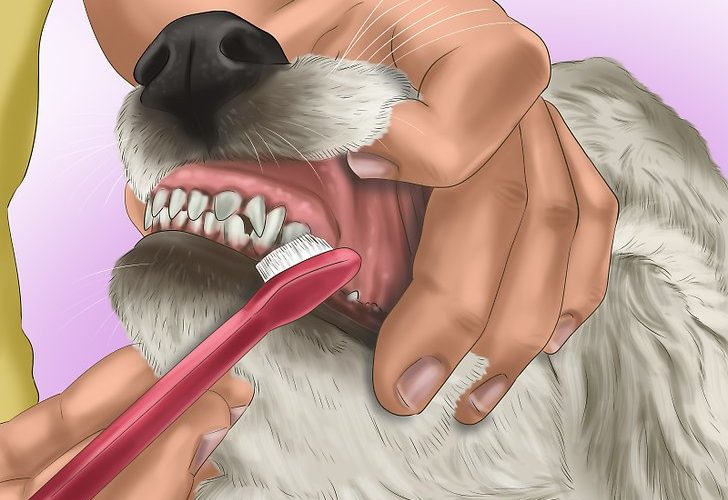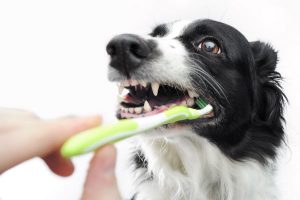#10 TRAIN YOUR PET TO TOLERATE IT
We’re not saying he’ll ever love it. But he should at least tolerate brushings.
Less than 10% of dogs are actually trained. It’s likely that an even smaller number is trained to accept a toothbrush or fingerbrush in their mouths. Hire a trainer if you must, but make a point of teaching him that the toothbrush is his friend.
#9 START EARLY
Ideally, all pets should be acclimated to brushing before they ever show signs of periodontal disease (80% of pets have periodontal disease by the age of three). Training always works best when you begin early — but don’t despair if you didn’t.
#8 LEARN HOW
Have someone actually demonstrate the procedure on your pet. Make little circling motions. Concentrate on the outside of the teeth. Skip the tongue.
But remember, you can’t do it all — especially if your pet is predisposed to serious gum disease. Regular dentals (as often as every six months for some pets) are strongly recommended for these guys … along with brushing, of course.
#7 LIGHTNING FAST BRUSHINGS ARE BETTER THAN NOTHING
It doesn’t have to take you forever. Half a minute of brushing twice a week is waaaaay better than skipping it altogether. You’d be surprised how effective just thirty seconds can be when it comes to removing early plaque.
#6 DON’T RELY ON OTHERS
Letting your groomer clean your dog’s teeth every few weeks is NOT a substitute for brushing your pet’s teeth at home and receiving routine dental care by your vet. Regardless of how it’s advertised, a groomer’s welcome addition to a pet’s dental regimen doesn’t mean it’s a panacea for everything dental that ails her.
#5 CHECK WITH YOUR VET FIRST
It’s not recommended you initiate a brushing regimen if you haven’t had your pet’s teeth evaluated first, especially if heavy tartar, bleeding gums and loose teeth are the case. You’re better off waiting for a proper professional cleaning than chancing the pain and severe discomfort that could be caused by brushing the dog’s teeth on your own.
#4 GET IT ALL OFF PROFESSIONALLY FIRST
Even mild to moderate tartar buildup won’t disappear with a single tooth brushing. Before you begin a new tooth brushing routine with your dog or pet, a round of professional cleaning is probably the first line of business.
#3 ASK HOW OFTEN BRUSHING IS NEEDED
“How often should I brush my dog’s teeth?” is the most common question on this subject. The answer: “It depends.” Once a week is the minimum. Twice a week for those more likely to develop plaque. Daily for severe periodontal disease patients.
#2 USE THE RIGHT TOOLS
Toothbrushes for pets are all the rage in pet stores. They sport fancy handles, angled bristles, finger attachments and super-fine fibers. But an extra-soft bristled baby toothbrush works great, too. And for those who won’t tolerate something hard in their mouths, we recommend a gauze sponge. Its rough surface is just nubbly enough to abrade the plaque … and not the gums. f your dog simply won’t tolerate you brushing its teeth, there are several toys designed with floss built right in, or you can give your dog a nice rawhide to chew on and help keep their teeth clean. If your dog simply won’t tolerate you brushing its teeth, there are several toys designed with floss built right in, or you can give your dog a nice rawhide to chew on and help keep their teeth clean.
#1 DON’T FORGET THE TOOTHPASTE!
Just as with the brushes, nothing fancy is needed here. Baking soda is good enough for cleaning dogs’ teeth, but flavored toothpaste for pets can sweeten the pot (poultry flavor, anyone?). When pets won’t tolerate fancy pet toothpaste or Arm & Hammer’s finest (or regular store-brand baking soda), even water on a brush beats not brushing at all. Just make sure you steer clear of fluoride-filled or artificially sweetened human-grade stuff. Remember, xylitol kills pets!
We are still having our Dental Special Month (10% off), give us a call at 509-924-4558 to reserve a spot for your best friend!
Thanks to PETMD for portions of this article


